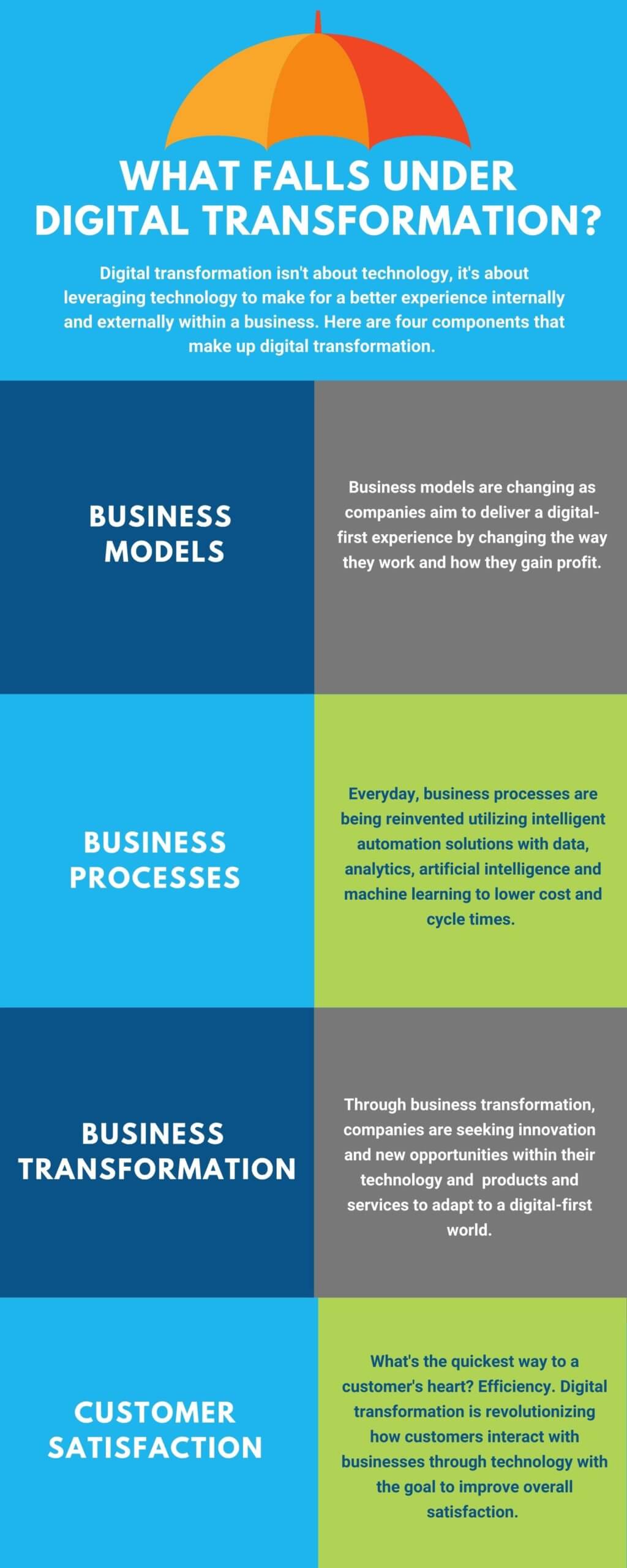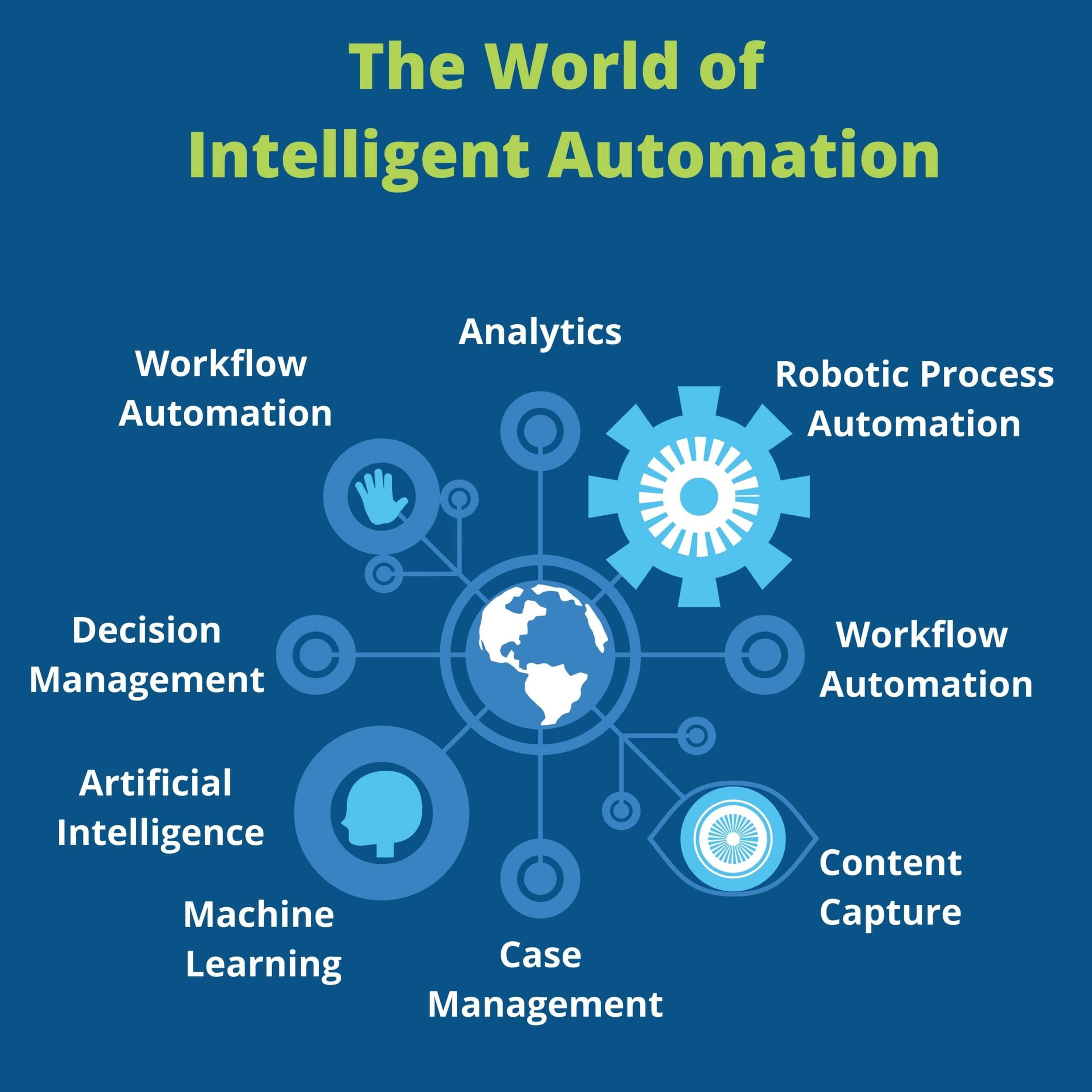
What is Intelligent Automation?
To put it simply, intelligent automation combines business processes with artificial intelligence and machine learning for the purpose of improving and enhancing productivity and customer satisfaction. Some examples of intelligent automation include:
- Automated workflows
- Forecasting outcomes based on data and analytics
- Capturing data and extracting it to the proper systems or file
And these are just the very basic examples. Within industries, intelligent automation serves an even more specific purpose. For the banking industry, intelligent automation can be used to make decisions on whether to approve a mortgage application or deny it, or in the case of insurance, streamline windshield claims or pull all the right information from all incoming claims content. These use cases are just the tip of the iceberg!
As intelligent automation grows more sophisticated, it’s becoming a must-have for businesses advancing towards digital transformation.
Digital Transformation and Intelligent Automation
Digital transformation utilizes technology, people and processes together to improve overall business performance, and note that digital transformation is different from intelligent automation. Intelligent automation focuses on business processes while digital transformation transforms how an organization operates with intelligent automation— and goes a step further by creating or unlocking new value for customers. With that said, intelligent automation is just one key part of digital transformation. Let’s take a closer look at digital transformation.
Digital transformation can be broken down into the following four areas:
Business Model: With competition heating up from digital-first companies, businesses are looking to transform their business model to keep up. This involves developing innovative strategies to change the business model from bringing in tech-savvy talent to moving to a digital-friendly platform, to drive value within the business and gain profit.
Business Transformation: For some companies, their offerings may be of lesser value or even becoming obsolete as technology advances. To keep up, companies look to transform their offerings whether it’s products or services to stay marketable against competition and gain customers.
Busines Processes: Within a business, there are many internal processes that take place in every department, and many of these processes could be automated to be more efficient. This is where Intelligent Automation comes in with robotic process automation, artificial intelligence, machine learning, workflow automation, natural language processing, content capture, decision management, analytics and other solutions to push processes to be more streamlined, and down the line, even forecast opportunities to identify new processes that can be automated.
Customer Experience: Of course, one of the main drivers in how businesses operate is their customers or if it’s not one of your main objectives it should be. If your customers are not being served well, that eventually equites to a loss of business. It’s no surprise that some businesses focus their digital transformation on delivering the best customer experience they can. Whether by implementing better communication solutions such as omnichannel or enhancing legacy systems with automation to deliver fast turnaround.

Intelligent Automation Possibilities
Just as intelligent automation falls under digital transformation, as mentioned above it focuses on optimizing the business processes inside an organization. With that there are several technologies aka possibilities for you to leverage and achieve intelligent automation.
Business Process Management
Business Process Management (BPM) involves assessing your core business processes and optimizing and automating them to increase efficiency. BPM can improve customer interactions, enhance internal employee experience, as well as automate work tasks. Depending on the type of process, BPM can be orchestrated in several ways using different technologies such as a third-party system and software or through RPA and AI.
Content Capture: NLP and OCR
Content capture is a way to extract data from documents usually with tools to help with this process — the two most common tools being Natural Language Processing (NLP) and Optical Character Recognition (OCR).
NLP is a way for computers to understand human languages using artificial intelligence by processing the language data and breaking it down by context and syntax to identify what words are being used and how they’re being used. And NLP is everywhere; in fact, it’s primarily what drives Apple’s Siri or Amazon’s Alexa to work. Another use case of NLP is within chatbots. For example, an insurance carrier could use a chatbot with NLP programming as a way for customers to get a quote or even file a claim.
OCR is the process of mechanically or electronically taking scanned images of handwritten or printed text and converting them digitally into machine-encoded text. OCR works by using character recognition to identify text and numbers with the purpose of extracting or analyzing information from documents and forms. One example of OCR being used is within the banking industry to verify checks delivered over an app when a client submits a photo of it.
Robotic Process Automation
Robotic process automation is a software that uses bots to automate repetitive tasks. RPA is used to automate basic tasks, including “swivel-chair tasks,” that involve manual, repetitive work. There are hundreds of ways RPA can be used, but to keep it simple, here are a few examples:
- Data entry
- Data extraction
- Customer onboarding
- Sales orders
Keep in mind these examples are just general use cases. Within industries, RPA serves a more specific purpose such as automating claims processing in insurance or improving mortgage loan underwriting. RPA is a fantastic solution for companies looking to start their automation on easy mode since it’s a user-friendly software that anyone can learn.
Workflow Automation
Workflow automation is a way to streamline work asks through automation. This is determined by creating pre-defined rules that can be assigned according to roles, documents or data. Workflow automation can be used in different ways including across different departments in HR, IT, sales, and marketing as well as through different industries including healthcare, insurance and banking. With workflow automation you can integrate other intelligent automation technologies such as RPA and decision management to help make workflows even more efficient or even tackle more complex workflows.
Analytics
Usually paired with artificial intelligence and machine learning, analytics can help with decision-making, performance, and even risk management within intelligent automation processes. Analytics are gathered in reports to help identify patterns to help automate decision-making, and in time, analytics can even predict outcomes for better business forecasting.
Decision Management
Did you know you can automate decision-making? Yes, it’s possible with decision management. Decision management is the ability to automate decision-making in business processes through rules, process, data and analytics. Decision management can help streamline and bypass certain processes that normally require a human decision maker — such as customer eligibility or approval for a loan or credit card — to drive efficiency and even increase customer satisfaction.
Case Management
With case management, you can automate and organize content and information more efficiently. Typically, case management is used with industries that handle client data, known as “cases,” and can be used in different ways including:
Service requests: Service requests are commonly associated with case management software. Take an IT department for example, a case management software can create alerts of a service request and notify the appropriate user, give a holistic view to all IT employees into the request and how it’s being handled, as well as provide report dashboards.
investigations: Investigations are brought up frequently in the insurance and financial institution space to deal with any issues or violations such as fraud, money laundering, and underwriting. Case management can help store and organize data relating to the case in question that’s being investigated, provide a platform to collaborate regarding the case with other users, and keep all data pertaining to the case safe and secure.
Incidents: Incidents are any unplanned events that occur that may disrupt operations. This could be applied to issues and incidents that IT has to deal with, for example, such as loss of internet connection or a frozen computer. Case management can help categorize incidents, automate assignments and help keep track of tasks to see how far along an incident has been resolved.
Artificial Intelligence and Machine Learning
Artificial intelligence is the ability to look at massive amounts of data to imitate human intelligence, reasoning and decision making to predict or even recommend what to do next. For automation purposes this means being able to automate more sophisticated tasks and even predicting processes that could be automated, as well.
Within artificial intelligence, machine learning is defined as a tool where a computer can “learn” from data looking at similar patterns. Machine learning can help with the automation process by being able to predict a decision a human would make from repeated patterns. For example, in the manufacturing industry, with enough data machine learning could be used to identify errors and anomalies within the manufacturing processes to ensure product quality.
What was once a technology that could only be used with scientists and developers, artificial intelligence has truly changed over time — and for the better. It’s estimated that in 2021, artificial intelligence will be more accessible company-wide allowing anyone to be able to develop digital workflow to streamline work processes, resulting in empowered employees, according to IDGConnect.

Benefits of Intelligent Automation
It’s no surprise that with everything intelligent automation can do, it brings a lot of benefits to business. Below are just a few of the many advantages:
Reduction of Cost
Intelligent automation really pays off! How much? According to Forbes, up to:
%
Improved Customer Satisfaction
With intelligent automation, you’ll see an improvement in customer satisfaction increase drastically. According to Gartner:
%
Projects related to customer experience are fueled with technology
Optimization of Workforce
According to McKinsey Digital, intelligent automation can handle:
%
of Work Tasks
Why Pyramid Solutions: Our Intelligent Automation Tools
As an Intelligent Automation partner, we host a whole suite of solutions to complement your enterprise, no matter if you’re just starting off and trying to figure out where or what processes can be automated to figuring out how you can get more ROI out of your tech.
- Content Capture Ingestion Methods (OCR and NLP)
- RPA
- Workflow automation
- Monitoring and Dashboards
- Document Viewing and Management
- Decision management
- Case Management
- Business process management
Looking for a next best step? Check out our following resources:
Business Process Management
RPA
Content Capture
- How to Fast-Track Applications: Natural Language Processing for Life Insurance
- On-Demand Webinar: Content Explained
Workflow Automation
Analytics
Or let us help you make your next step. We’re currently offering free assessments to see how intelligent automation can work for you.
Get a Free Assessment.
Ready to take your first step towards intelligent automation? We can help. Reach out to get a free assessment that comes with a roadmap to see what you’r best opportunities are for intelligent automation.
